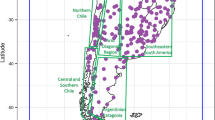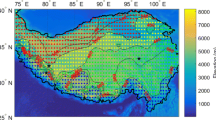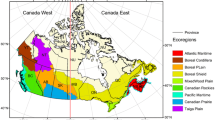Abstract
The relationship between the large-scale circulation dynamics and regional precipitation regime in the Tibetan Plateau (TP) has so far not been well understood. In this study, we classify the circulation types using the self-organizing maps based on the daily field of 500 hPa geopotential height and link them to the precipitation climatology in the eastern and central TP. By virtue of an objective determining method, 18 circulation types are quantified. The results show that the large amount of precipitation in summer is closely related to the circulation types in which the enhanced and northward shifted subtropical high (SH) over the northwest Pacific and the obvious cyclconic circulation anomaly over the Bay of Bengal are helpful for the Indian summer monsoon and East Asian summer monsoon to take abundant low-latitude moisture to the eastern and southern TP. On the contrary, the dry winter in the central and eastern Tibet corresponds to the circulation types with divergence over the central and eastern TP and the water vapor transportations of East Asian winter monsoon and mid-latitude westerly are very weak. Some circulation types are associated with some well-known circulation patterns/monsoons influencing the TP (e.g. East Atlantic Pattern, El Niño Southern Oscillation, Indian Summer Monsoon and the mid-latitude westerly), and exhibit an overall good potential for explaining the variability of regional seasonal precipitation. Moreover, the climate shift signals in the late 1970s over the eastern Pacific/North Pacific Oceans could also be reflected by both the variability of some circulation types and their correspondingly composite precipitations. This study extends our understandings for the large-scale atmospheric dynamics and their linkages with regional precipitation and is beneficial for the climate change projection and related adaptation activities in the highest and largest plateau in the world.











Similar content being viewed by others
References
Barmston A, Livezey RE (1987) Classification, seasonality and persistence of low frequency atmospheric circulation patterns. Mon Wea Rev 82:1083–1126
Belleflamme A, Fettweis X, Erpicum M (2015) Do global warming-induced circulation pattern changes affect temperature and precipitation over Europe during summer? Int J Climatol 35(7):1484–1499
Bothe O, Fraedrich K, Zhu XH (2010) Large-scale circulations and Tibetan Plateau summer drought and wetness in a high-resolution climate model. Int J Climatol 31(6):823–846
Bothe O, Fraedrich K, Zhu XH (2012) Tibetan Plateau summer precipitation: covariability with circulation indices. Theor Appl Climatol 108:293–300
Cassano EN, Lynch AH, Cassano JJ, Koslow MR (2006) Classification of synoptic patterns in the western Arctic associated with extreme events at barrow, Alaska, USA. Clim Res 30:83–97
Cavazos T (2000) Using self-organizing maps to investigate extreme climate events: an application to wintertime precipitation in the Balkans. J Clim 13:1718–1732
Chan JCL, Zhou W (2005) PDO, ENSO and early summer monsoon rainfall over South China. Geophys Res Lett 32:L08810. doi:10.1029/2004GL022015
Chen DL (2000) A monthly circulation climatology for Sweden and its application to a winter temperature case study. Int J Climatol 20:1067–1076
Duan AM, Wu GX (2006) Change of cloud amount and the climate warming on the Tibetan Plateau. Geophys Res Lett 33:L22704. doi:10.1029/2006GL027946
Feng L, Zhou TJ (2012) Water vapor transport for summer precipitation over the Tibetan Plateau: multidata set analysis. J Geophys Res 117:D20114. doi:10.1029/2011JD017012
Gao Y, Wang HJ, Li SL (2013) Influences of the Atlantic Ocean on the summer precipitation of the southeastern Tibetan Plateau. J Geophys Res 118:3534–3544. doi:10.1002/jgrd.50290
Graham NE (1994) Decadal scale variability in the 1970’s and 1980’s: observations and model results. Clim Dyn 10:60–70
Guilderson TP, Schrag DP (1998) Abrupt shift in subsurface temperatures in the tropical Pacific associated with changes in El Niño. Science 281(5374):240–243
Gutiérrez JM, Cano R, Cofiño AS, Sordo C (2005) Analysis and downscaling multi-model seasonal forecasts in Peru using self-organizing maps. Tellus 57A:435–447
Hewitson BC, Crane RG (2002) Self-organizing maps: applications to synoptic climatology. Clim Res 22:13–36
Huth R, Beck C, Philipp A, Demuzere M, Ustrnual Z, Cahynová M, Kyselý J, Tveito OE (2008) Classifications of atmospheric circulation patterns: recent advances and applications. Trends Dir Clim Res Ann NY Acad Sci 1146:105–152
Iglesias I, Lorenzo MN, Taboada JJ (2014) Seasonal predictability of the East atlantic pattern from sea surface temperatures. PLoS One 9(1):e86439
Immerzeel WW, van Beek LPH, Bierkens MFP (2010) Climate change will affect the Asian water towers. Science 328:1382–1385
IPCC (2013) Climate Change 2013: the physical science basis. contribution of working group i to the fifth assessment report of the intergovernmental panel on climate change. In: Stocker TF, Qin D, Plattner G-K, Tignor M, Allen SK, Boschung J, Nauels A, Xia, Bex V, Midgley PM (eds). Cambridge University Press: Cambridge, United Kingdom and New York, NY, USA, p 1535
James PM (2007) An objective classification method for Hess and Brezowsky Grosswetterlagen over Europe. Theor Appl Climatol 88:17–42
Johnson NC (2013) How many ENSO flavors can we distinguish? J Clim 26:4816–4827
Johnson NC, Feldstein SB (2010) The continuum of North Pacific Sea level pressure patterns: intraseasonal, interannual, and interdecadal variability. J Clim 23:851–867
Johnson NC, Feldstein SB, Tremblay B (2008) The continuum of Northern Hemisphere teleconnection patterns and a description of the NAO shift with the use of self-organizing maps. J Clim 21:6354–6371
Kalnay E et al (1996) The NCEP/NCAR 40-year reanalysis project. Bull Am Meteorol Soc 77:437–471
Kohonen T (1995) Springer series in information sciences. In: Self-Organizing Maps, vol 30. Springer, Berlin
Kohonen T (2001) Springer series in information sciences. In: Self-Organizing Maps, 3rd edn, vol 30. Springer, Berlin
Lamb HH (1950) Types and spells of weather around the year in the British Isles: annual trends, seasonal structure of the year, singularities. Q J R Meteorol Soc 76:393–429
Lei YB, Yang K, Wang B, Sheng YW, Bird BW, Zhang GQ, Tian LD (2014) Response of inland lake dynamics over the Tibetan Plateau to climate change. Clim Change 125:281–290
Lennard C, Hegerl G (2014) Relating changes in synoptic circulation to the surface rainfall response using self-organising maps. Clim Dyn 44:861–879
Li J, Wang JX (2003) A modified zonal index and its physical sense. Geophys Res Lett 30:1632
Li J, Zeng QC (2003) A new monsoon index and the geographical distribution of the global monsoons. Adv Atmos Sci 20:299–302
Liu YG, Weisberg RH (2011) A review of self-organizing map applications in meteorology and oceanography. In: Mwasiagi JI (ed) Self organizing maps - applications and novel algorithm design, InTech. ISBN:978-953-307-546-4. http://www.intechopen.com/books/selforganizing-maps-applications-and-novel-algorithm-design/a-review-of-self-organizing-map-applications-inmeteorology-and-oceanography
Liu XD, Yin ZY (2001) Spatial and temporal variation of summer precipitation over the eastern Tibetan Plateau and the North Atlantic oscillation. J Clim 14:2896–2909
Liu YG, Weisberg RH, Christopher NLM (2006) Performance evaluation of the self-organizing map for feature extraction. J Geophys Res 111:C05018. doi:10.1029/2005JC003117
Liu WB, Fu GB, Liu CM, Charles SP (2013) A comparison of three multi-site statistical downscaling models for daily rainfall in the North China Plain. Theor Appl Climatol 111:585–600
Liu WB, Zhang AJ, Wang L, Fu GB, Chen DL, Liu CM, Cai TJ (2015) Projecting streamflow in the Tangwang river basin (China) using a rainfall generator and two hydrological models. Clim Res 62:79–97
Miller AJ, Cayan DR, Barnett TP, Graham NE, Oberhuber JM (1994) The 1976–1977 climate shift of the Pacific Ocean. Oceanography 7(1):21–26
Pettitt AN (1979) A non-parametric approach to the change point problem. Appl Stat 28(2):126–135
Philipp A, Beck C, Huth R, Jacobeit J (2014) Development and comparison of circulation type classifications using the COST 733 dataset and software. Int J Climatol. doi:10.1002/joc.3920
Rousi E, Anagnostopoulou C, Tolika K, Maheras P (2015) Representing teleconnection patterns over Europe: a comparison of SOM and PCA methods. Atmos Res 152:123–137
Sammon JW (1969) A nonlinear mapping for data structure analysis. IEEE Trans Comput C-18:401–409
Schiemann RD, Schaer C (2009) Seasonality and interannual variability of the westerly jet in the Tibetan Plateau region. J Clim 22:2940–2957
Sheridan SC, Lee CC (2011) The self-organizing map in synoptic climatological research. Prog Phys Geogr 35:109. doi:10.1177/0309133310397582
Sugimoto S, Ueno K, Sha W (2008) Transportation of water vapor into the Tibetan Plateau in the case of a passing synoptic-scale trough. J Meteorol Soc Jpn 86:935–949
Trenberth KE (1997) The definition of El Niño. Bull Am Meteorol Soc 78:2771–2777
Tveito OE (2010) An assessment of circulation type classifications for precipitation distribution in Norway. Phys Chem Earth 35:395–402
Verdon-Kidd DC, Kiem AS (2009) On the relationship between large-scale climate modes and regional synoptic patterns that drive Victorian rainfall. Hydrol Earth Syst Sci 13:467–479
Vesanto J, Himberg J, Alhoniemi E and Parhankangas J (2000) SOM toolbox for Matlab 5, report, Helsinki Univ. of Technol., Helsinki, Finland
Wang B, Wu R, Lau KM (2001) Interannual variability of Asian summer monsoon: contrast between the Indian and western North Pacific-East Asian monsoons. J Clim 14:4073–4090
Webster PJ, Magaña VO, Palmer TN, Shukla J, Tomas RA, Yanai M, Yasunari T (1998) Monsoons: processes, predictability, and the prospects for prediction. J Geophys Res 103(C7):14451–14510. doi:10.1029/97JC02719
Yang K, Ye B, Zhou D, Wu B, Foken T, Qin J, Zhou Z (2011) Responses of hydrological cycle to recent climate changes in the Tibetan Plateau. Clim Change 109:517–534
Yang K, Wu H, Qin J, Lin CG, Tang WJ, Chen YY (2014) Recent climate changes over the Tibetan Plateau and their impacts on energy and water cycle: a review. Glob Planet Change 112:79–91
Yao TD, Thompson L, Yang W, Yu WS, Gao Y, Guo XJ, Yang XX, Duan KQ, Zhao HB, Xu BQ, Pu JC, Lu AX, Xiang Y, Kattel DB, Joswiak D (2012) Different glacier status with atmospheric circulations in Tibetan Plateau and surroundings. Nat Clim Change 2:1–5
Yarnal B, Comrie AC, Frakes B, Brown DP (2001) Developments and prospects in synoptic climatology. Int J Clim 21:1923–1950
Yin ZY, Liu XD, Zhang XQ, Chung CF (2004) Using a geographic information system to improve special sensor microwave imager precipitation estimates over the Tibetan Plateau. J Geophys Res 109:D03110. doi:10.1029/2003JD003748
You QL, Kang SC, Aguilar E, Yan YP (2008) Changes in daily climate extremes in the eastern and central Tibetan Plateau during 1961–2006. J Geophys Res 113:D07101. doi:10.1029/2007JD009389
Zhang XL, Yan XD (2015) A new statistical precipitation downscaling method with Baysian modelaveraging: a case study in China. Clim Dyn. doi:10.1007/s00382-015-2491-7
Zhao HB, Xu BQ, Yao TD, Wu GJ, Lin SB, Gao J, Wang M (2012) Deuterium excess record in a southern Tibetan ice core and its potential climatic implications. Clim Dyn 38:1791–1803
Zhu CW, Wang B, Qian WH, Zhang B (2012) Recent weakening of northern East Asian summer monsoon: a possible response to global warming. Geophys Res Lett 39:L09701. doi:10.1029/2012GL051155
Acknowledgments
This study was financially supported by the National Key Basic Research Program of China (2013CBA018), the “Strategic Priority Research Program” of the Chinese Academy of Sciences (XDB03030302) and the National Natural Science Foundation of China (Grant 41401037 and 41322001). Lei Wang was also supported by the Hundred Talent Programs of Chinese Academy of Sciences. We also wish to thank the editor and two anonymous reviewers for their invaluable comments and constructive suggestions used to improve the quality of the manuscript.
Author information
Authors and Affiliations
Corresponding author
Rights and permissions
About this article
Cite this article
Liu, W., Wang, L., Chen, D. et al. Large-scale circulation classification and its links to observed precipitation in the eastern and central Tibetan Plateau. Clim Dyn 46, 3481–3497 (2016). https://doi.org/10.1007/s00382-015-2782-z
Received:
Accepted:
Published:
Issue Date:
DOI: https://doi.org/10.1007/s00382-015-2782-z




